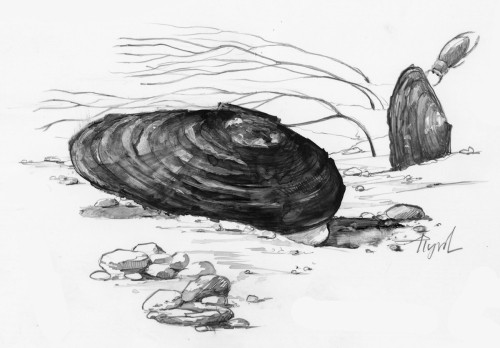
Freshwater mussels are not exactly charismatic. They don’t flit gracefully about like a Karner blue butterfly, or munch on clover like a cottontail. They aren’t known for their sweet songs like a wood thrush, and they don’t close down traffic on the first rainy night of spring like spotted salamanders. They are fish parasites at one stage of their lives, and they don’t even taste good like their saltwater cousins.
But America can boast that it is home to the greatest variety of freshwater mussels in the world, so there’s that. And if you were wondering what the most imperiled fauna was in North America, according to the New Hampshire’s Wildlife Action Plan, mussels take top honors. Many freshwater mussels in the United States are on the verge of extinction, though we’ve hardly noticed. We barely ever see them, and when we do it’s most often their empty shells, licked clean by raccoons, or on antiques in the form of buttons or fancy inlays.
In many ways, the story of the freshwater mussels decline is linked to the story of our own growth. Take the brook floater mussel, Alasmidonta varicose. Once found from Nova Scotia to South Carolina, the brook floater was widespread throughout its range. Their yellowish-green to brownish-black shells could be found snugged into the clean waters of cobbled stream and river bottoms of New England. But almost two centuries of development along our streams and rivers has led to pollution, sedimentation, increased nutrient loading, and alterations to the natural flow of rivers. These human-driven factors have all taken their toll on this small sensitive mussel. Recently, the New Hampshire Fish and Game Department reported that over 70 percent of the surveyed brook floater populations had less than 30 individuals.
Freshwater mussels have withstood much over the 240 million years they have existed. But now, according to Dr. Barry Wicklow, an aquatic ecologist at St. Anselm College, the brook floater is in trouble. In fact, scientists have petitioned the federal government to consider listing it as an endangered species, an act that would give it protection, make funds available for further study, and perhaps lead to reintroduction plans.
According to Wicklow, who has been studying the brook floater mussel since he discovered a population in the Piscataquog River in 1994, this small bivalve is an essential component of a healthy river. He describes how they do the dirty work of cleaning the water by filtering contaminants and sediments through the simple act of eating and digesting. He points out that they’re also a valuable food source to the lower portions of the food chain. He adds, “The more I learn, the more I understand that this fauna – invisible to most people – is not only ecologically important but also astonishing in their diversity and adaptations.”
Not that long ago my young son and I were looking at a mussel collection recently donated to the nature center where I work. He was holding a brook floater shell in his small hand, letting his fingers run over the shimmery inside of the shell while I told him the story of how mussels reproduce: how the females hold the fertilized eggs in a special chamber in their shell that keeps them protected all summer, fall, and winter, and then in spring, how the little larvae get exhaled from the mother and float through the water in thick strands until a fish swims by and the larva hitch a ride on the fish. For a few weeks, the larva is on the fish, encased in its gills, growing and slowly changing into a mussel in miniscule that is released from the fish to settle into the pebbly bottom of the stream.
He listened all the while turning the shell around and around. Finally he looked up and said that he would like to be this mussel one day -- that it sounded like a safe way to be an animal, how good it must feel to live inside a shell so shiny and smooth inside and how much fun it would be to do your growing up on a fish’s gill.
As I hold the brook floater shell in my hand, running my thumb over its rough outside shell, I imagine the small soft body that once called this shell home. Something maternal in me flares. I want to curl around it and protect it for my own child, for its children, for our planet.


Discussion *